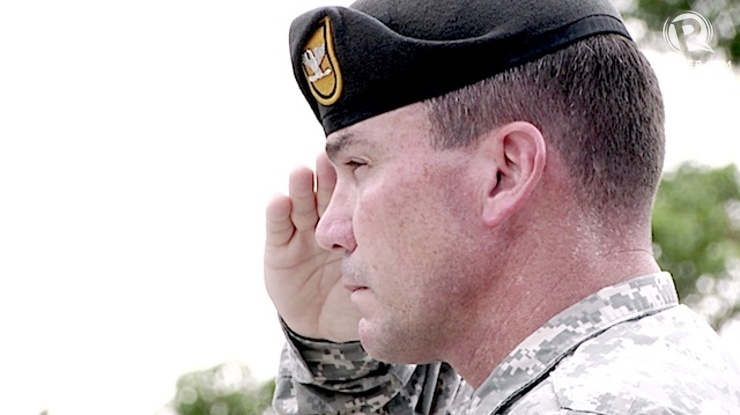As the defense agreement is scrutinized on the national stage, the issues raised by local officials with 'semi-permanent US presence' are repeated

JSOTF-P COMMANDER: US Army Green Beret Colonel Robert McDowell
When the Enhanced Defense Cooperation Agreement (EDCA) was signed, a
politician in Zamboanga City asked on Twitter: "I wonder what
consequences it will have on LGUs who host semi-permanent US
While
The difference is EDCA, for Filipinos, is meant to counter a growingly
aggressive China
"We call it one of the most successful foreign internal defense
counterterrorist operations that we’ve ever had the pleasure to be a part
of," McDowell told repoters in a rare interview in Nueva Ecija, where he
joined Balikatan 2014 activities.
Nothing newThose who are familiar with US military activities in
For EDCA, the locations have yet to be determined. For JSOTF-P ,
US troops put up facilities
in Camp Navarro
in Zamboanga City ,
Camp Siongco
in Maguindanao, and Camp
Bautista
At its peak, up to 1,200 US troops have rotated in
"The mission that we were helping to do with the counterterrorism has
greatly improved since the beginning. We still have many people in the southern
Philippines Philippines
Even as maritime security takes center stage, McDowell said
counterterrorism exercises will continue.
"Nothing will change that we are already doing right now. We are
working very closely with the navy. We work with the Coast Guard. We work with
the Armed Forces in general," he said.
"If anything, we will find ways to increase the cooperation that we do
for the security of the
Smart bombs in Sulu
The training exercises in 
ATTACK. A smart bomb is used against the Abu Sayyaf. Rappler file photo
Zulkifli bin Hir
carried a US$5-million reward on his head, while Mohammed Abdullah Ali carried
a $500,000 reward. (Read the exclusive report of Rappler executive editor Maria
Ressa here.)
A live feed from
a Scan Eagle unmanned aerial
vehicle (UAV) or drone showed what was happening inside an Abu
Sayyaf camp in Sulu, allowing a joint team of Filipino and US troops to compare
the thermal image with what a double agent was texting them.
A July 6, 2012 New
York Times article by Mark Mazzetti,
"The Drone Zone," also claimed that the US
conducted lethal drone operations in the Philippines Philippines
Drones are used
only for surveillance, they said.
Access to
bases
McDowell sought
to assuage fears of EDCA. "We are not going to create new bases. We serve
at the pleasure of the Philippine government and we work in numbers that are
acceptable to the Filipino people as a whole and what the government
allows," said McDowell.
But the issue
repeatedly raised against JSOTF-P is how it refuses Filipino troops access to
its facilities. The US
troops have a small facility inside Camp
Navarro in Zamboanga City
EDCA is supposed
to address this issue. It allows designated officials access to locations that
will be offered for the use of the Americans. But there are doubts this will
happen.
"You and I
know that we are not going to be allowed to check those facilities,"
Senator Sergio Osmeña III said during a Senate hearing on EDCA on May 13. They
were discussing the prohibition on the entry of nuclear weapons.
More
congressional hearings are scheduled to look into the constitutionality of
EDCA. While many lawmakers support defense cooperation with the US
Time is not a
luxury, however. The longer the debate on EDCA takes, the longer it will take
the Philippines to identify the locations it will give the US troops, and the
longer it will take the US to build the facilities they need to bring in their
defense assets that the Philippines wants prepositioned in the country.
As the maritime
disputes escalate to a fever pitch, security officials highlight the need to
have those assets as soon as possible.
http://www.rappler.com/nation/57985-edca-zamboanga-jsotf-joint-operations

No comments:
Post a Comment
Note: Only a member of this blog may post a comment.